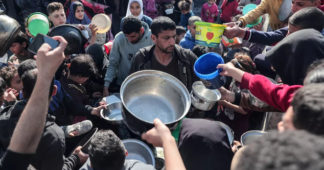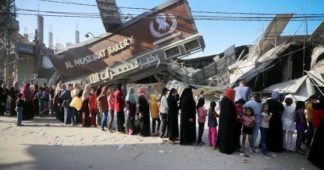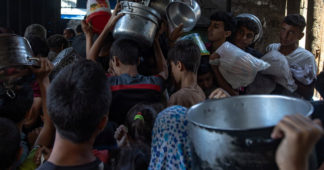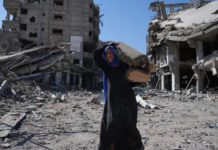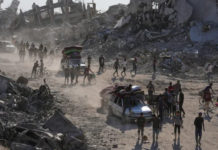By Ghada Abu Muaileq , Truthout
Aug 23, 2025
We tear up chairs for firewood. Soap is watered down to make it last. Basic necessities are increasingly out of reach.
As we live in Gaza under the fear of rockets and Israeli bombardment, and with looming threats of an invasion by the Israeli government in full view of the world, in our markets, residents are fighting yet another war — one against soaring prices. It is a war that has drained pockets, exhausted people, and turned daily life into a burden no less cruel than the bombing. The calls of street vendors echo between the narrow alleys and their prices seem to float upward without limit, while purchasing power shrinks by the day. The blockade chokes the the whole Strip; salary cuts deepen the struggle; and battered banknotes are often rejected by shopkeepers. The challenge is no longer only to secure food, but also to obtain the most basic non-food necessities, which have themselves become luxuries in wartime.
Among the goods that have, tragically, become “war necessities” in Gaza is wood, which became increasingly important after cooking gas ran out and Israel banned its entry. With demand surging ever since Israel resumed its war after breaking the ceasefire, people began breaking apart their own wooden belongings or scavenging rubble for pieces to burn for cooking or heating water.
In my own family, we dismantled our wooden chairs and even cut the branches of the rose bushes we had planted in our garden, which once gave our home a touch of beauty. We were not alone. Our neighbors cut down all the olive trees their grandfather had planted. The soaring price of firewood forces us to burn anything made of wood before we even think of buying ready-cut wood — which, in any case, often comes from olive trees or other trees that survived the bulldozing of farmland by Israeli tanks. Venturing into border areas to collect wood is a dangerous gamble; the army designates such areas as “red zones.” When we bought enough wood just to bake bread, it cost us about U.S. $16 — and that was just the cost of cooking material. Meanwhile, ingredients essential for making bread, like flour and yeast, came to around $73 last month amid constantly fluctuating prices that rise or fall depending on traders’ decisions and the number of trucks Israel allows in.
The cost is not just financial; our bodies pay a heavy price. My brother grows exhausted chopping wood by hand, while the smoke from burning it causes him shortness of breath and stings his eyes. My mother sits by the fire for nearly an hour to prepare a simple meal that would take half the time or less when cooking with gas. Day after day, I watch her body weaken, her back ache, her hands darken from the flames. Even my own hands have grown dry from washing blackened pots and pans covered with soot and ash, especially now that good-quality dish soap has disappeared from the shelves.
Once, I sent my brother Musab to buy dish soap. He came back with a poor-quality, locally-made product sold at a high price. With raw materials depleted and factories lacking the means to produce quality goods, local detergents are watery and weak, forcing us to use much more to get dishes clean. Shampoo is the same — mostly water, tinted with color and a little soap, ineffective for washing hair. A liter of these local cleaning products costs between $10 and $15, while a “lucky” find of an imported shampoo costs $26. Even water for washing dishes or bathing now requires a long walk under the sun, hauling a barrel to the nearest filling station, where a generator pumps water from a well for a fee of about $26 — enough for just one family. Larger families need to refill more than once a day.
During one trip to the market, my heart ached as I remembered when our shops were filled with elegant, fashionable clothes. Now, looking at the racks before us, we had no choice but to buy the poor-quality clothes in their faded colors. My sister joked as we headed to a stationery store that she would throw away the clothes she bought during the war and replace them with colorful, trendy outfits in the latest fashions. But as she said this, I fell silent, wondering: The latest fashions of which year? Will the war really end this year, or will it drag on for more than two?
My thoughts were cut short by the voice of the shop owner telling me that printing my university slides would cost $43. I had expected a high price, but not this high — printing the same material used to cost no more than $15. Seeing my surprise, he explained that printer ink is running out in the Strip and that he now must buys it at an inflated price. The high cost of electricity also boosts the price up even further. When I asked about pens and notebooks, he told me a single pen costs $1.50, and a 60-page notebook costs $17.
I left the shop feeling hopeless about Gaza and the level of devastation that has been imposed on us. As usual, I found no transport home — many cars have been destroyed, and fuel shortages are severe. If you find a vehicle to take you anywhere, you’re lucky. The only option now is a large, open truck with a roof covering, fitted with long benches that seat about ten people, while the rest stand on a small platform at the back. It’s a makeshift invention you’d only see in Gaza, along with donkeys and horses used for transportation.
I sat in the truck with about ten other passengers, mostly women. The weariness was plain on their faces, a lifeless pallor the war had painted on them. All the talk was about prices that fluctuate as if they are determined by the stock market — a pack of ten diapers costs $29 while infant formula and other baby needs are unaffordable. Some had sold their gold, others discussed what to cook that day, the commission rates that had reached 50 percent. They spoke of shopkeepers refusing to accept paper currency; sellers charge higher prices for payments made via bank transfer instead of cash — for example, a $50 bag of sugar might cost $70 if paid through the bank. Stories piled one upon another, each one a window into a life few outside of Gaza have ever felt, a life that has left most people here walking as bodies without souls — the living dead.
Even the “luxury” of death has become more expensive in Gaza. Dying is the easiest thing here, but after death, a grave — including digging, stones, and labor — costs between $290 and $377. Because of the lack of space, workers often bury more than one body in the same grave. When my grandfather passed away a few months ago he was buried above the grave of his brother, who died long ago. This is a glimpse into daily life here: whether alive or dead, you have to pay.
This battle that every resident of Gaza is forced to fight is one born of a deliberate policy imposed by Israel. It leaves the average Palestinian in Gaza to ask the same question day after day: Have prices gone down today?
We remind our readers that publication of articles on our site does not mean that we agree with what is written. Our policy is to publish anything which we consider of interest, so as to assist our readers in forming their opinions. Sometimes we even publish articles with which we totally disagree, since we believe it is important for our readers to be informed on as wide a spectrum of views as possible.
